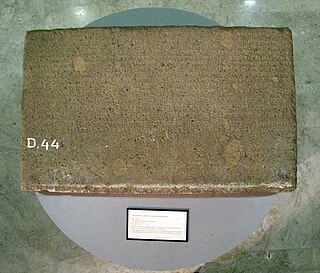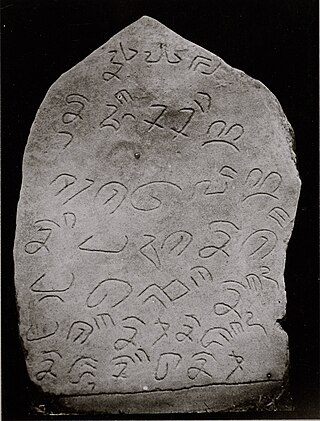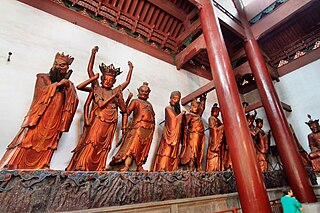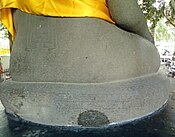
Srivijaya was a Buddhist thalassocratic empire based on the island of Sumatra, which influenced much of Southeast Asia. Srivijaya was an important centre for the expansion of Buddhism from the 7th to the 12th century AD. Srivijaya was the first polity to dominate much of western Maritime Southeast Asia. Due to its location, the Srivijaya developed complex technology utilizing maritime resources. In addition, its economy became progressively reliant on the booming trade in the region, thus transforming it into a prestige goods-based economy.

Vajrapāṇi is one of the earliest-appearing bodhisattvas in Mahayana Buddhism. He is the protector and guide of Gautama Buddha and rose to symbolize the Buddha's power.
Bhagavan, also spelt Bhagwan, is an epithet within Indian religions used to denote figures of religious worship. In Hinduism it is used to signify a deity or an avatar, particularly for Krishna and Vishnu in Vaishnavism, Shiva in Shaivism and Durga or Adi Shakti in Shaktism. In Jainism the term refers to the Tirthankaras, particularly Mahavira, and in Buddhism to the Buddha.

The Mataram Kingdom ; also known as Medang Kingdom was a Javanese Hindu–Buddhist kingdom that flourished between the 8th and 11th centuries. It was based in Central Java, and later in East Java. Established by King Sanjaya, the kingdom was ruled by the Shailendra dynasty and Ishana dynasty.
The Western Satraps, or Western Kshatrapas were Indo-Scythian (Saka) rulers of the western and central part of India, between 35 to 415 CE. The Western Satraps were contemporaneous with the Kushans who ruled the northern part of the Indian subcontinent, and were possibly vassals of the Kushans. They were also contemporaneous with the Satavahana (Andhra) who ruled in Central India. They are called "Western Satraps" in modern historiography in order to differentiate them from the "Northern Satraps", who ruled in Punjab and Mathura until the 2nd century CE.

A candi is a Hindu or Buddhist temple in Indonesia, mostly built during the Zaman Hindu-Buddha or "Hindu-Buddhist period" between circa the 4th and 15th centuries.

Tarumanagara or Taruma Kingdom or just Taruma is an early Sundanese Indianised kingdom, located in western Java, whose 5th-century ruler, Purnawarman, produced the earliest known inscriptions in Java, which are estimated to date from around 450 CE.

The Sunda Kingdom was a Sundanese Hindu kingdom located in the western portion of the island of Java from 669 to around 1579, covering the area of present-day Banten, Jakarta, West Java, and the western part of Central Java. The capital of the Sunda Kingdom moved several times during its history, shifting between the Galuh (Kawali) area in the east and Pakuan Pajajaran in the west.

Sri Kesari Warmadewa was the first king of Bali whose name is recorded in a written inscription. He was the issuing authority for four inscriptions, including the famous 914 CE inscription on the Belanjong pillar in southern Sanur.

The Belanjong pillar, also Blanjong pillar or Blanjong inscription, is a pillar established in 914 CE in the harbour of Belanjong, in the southern area of Sanur in Bali.
The Mantyasih inscription is an important inscription found and kept by Li Djok Ban in Ngadireja Parakan Temanggung, then the inscription was brought by one of the princes of Surakarta to be brought to Surakarta and is now stored in the Radyapustaka Museum, Central Java, Indonesia. It is dated to 907 and was created by King Balitung from the Sanjaya dynasty, of the Ancient Mataram Kingdom. This inscription contains a genealogy of the kings of Mataram before King Balitung.

The Padang Roco Inscription, in Indonesian Prasasti Padang Roco, is an inscription dated 1286 CE, discovered near the source of Batanghari river, Padangroco temple complex, Nagari Siguntur, Sitiung, Dharmasraya Regency, West Sumatra, Indonesia.

The Kelurak inscription is an inscription dated 704 Saka, written in Sanskrit with Pranagari script, discovered near Lumbung temple in Kelurak village, Central Java, Indonesia. Lumbung temple is a bit north of Prambanan temple in Yogyakarta.
Calcutta Stone or known in Indonesia as Pucangan Inscription is an ancient Javanese inscription written in Sanskrit and Old Javanese, dated from 1041 CE during the reign of king Airlangga of the Kahuripan kingdom, that explains some events and the royal genealogy of the king. The inscription more or less narrates the life story of King Airlangga, one of the greatest king in Javanese history, also explaining his lineage as the rightful ruler of Java, the successor of King Dharmawangsa of Isyana dynasty. This inscription was known as "Calcutta Stone", because it is stored in Indian Museum, Kolkata (Calcutta), India from 19th century until today.

Purnawarman or Purnavarman is the 5th-century king of Tarumanagara, a Hindu Indianized kingdom, located in modern-day West Java, Jakarta and Banten provinces, Indonesia. Purnawarman reigned during the 5th century, and during his reign he created several stone inscriptions.

Ciaruteun inscription also written Ciarutön or also known as Ciampea inscription is a 5th-century stone inscription discovered on the riverbed of Ciaruteun River, a tributary of Cisadane River, not far from Bogor, West Java, Indonesia. The inscription is dated from the Tarumanagara kingdom period, one of the earliest Hindu kingdoms in Indonesian history. The inscription states King Purnawarman is the ruler of Tarumanagara.

Gajah Mada inscription also known as Singhasari inscription, is an inscription written in old Javanese script, dated to 1273 Saka or corresponds to 1351 CE from Majapahit period, discovered in Singosari district, Malang Regency, East Java. The inscription is now preserved in National Museum of Indonesia in Jakarta under inventory number D 111. The inscription was carved on a smooth surface, and the letters are clearly legible.

Old Sundanese is the earliest recorded stage of the Sundanese language which is spoken in the western part of Java, Indonesia. The evidence is recorded in inscriptions from around the 12th to 14th centuries and ancient palm-leaf manuscripts from the 15th to 17th centuries AD. Old Sundanese is no longer used today, but has developed into its descendant, modern Sundanese.

The Twenty-Four Protective Deities or the Twenty-Four Devas, sometimes reduced to the Twenty Protective Deities or the Twenty Devas, are a group of dharmapalas in Chinese Buddhism who are venerated as defenders of the Buddhist dharma. The group consists of devas, naga kings, vajra-holders and other beings, mostly borrowed from Hinduism with some borrowed from Taoism.
















